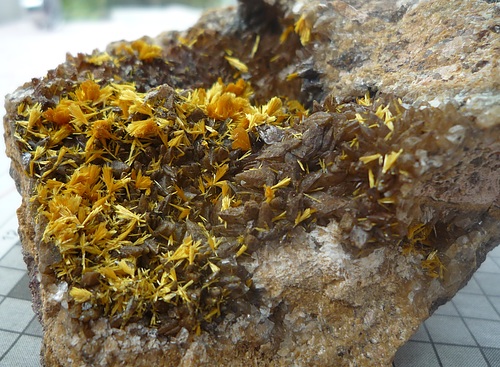Florian Baur's Photo Gallery
CL3-7D1Studtite [(UO2)(O2)(H2O)2]·H2O , Uranophane Ca(UO2)2(SiO3OH)2·5H2O
Krunkelbach Valley Uranium deposit, Menzenschwand, St Blasien, Waldshut, Freiburg Region, Baden-Württemberg, GermanyDimensions: 55 mm x 60 mm x 55 mm
Field of View: 15 mm
Largest Crystal Size: 5 mm
This is pale yellow Studtite and canary yellow Uranophane. The Studtite was EDX analyzed and has formed hairlike needles 2-3 µm in diameter that are loosely covering the Uranophane tufts. The Studtite patch is about 10 mm long which is quite rich for the species.
Studtite is the only known peroxide mineral. It is assumed to form when a radioactive mineral (in this case Uranophane) is covered by a thin layer of water. The radiation causes the water to form a few H2O2 (hydrogen peroxide) molecules. If left undisturbed over thousands of years eventually enough H2O2 has formed to combine with uranium and yield Studtite.
This genesis would explain why the Studtite is covering the Uranophane.
8TL-GJLFrancevillite Ba(UO2)2(VO4)2·5H2O , Curienite Pb(UO2)2(VO4)2·5H2O , Mounanaite PbFe3+2(VO4)2(OH,F)2
Mounana Mine, Mounana, Léboumbi-Leyou Department, Haut-Ogooué Province, GabonDimensions: 8 cm x 6 cm x 2 cm
Field of View: 30 mm
Largest Crystal Size: 3 mm
Here Mounana Mine's common association of Francevillite (orange), Curienite (yellow) and Mounanaite (black) can be seen.
I couldn't capture the vivid color of the Francevillite crystals, in reality it's more orange and contrasts strongly with the yellow Curienite.
The specimen is ex Tom McKee.
HU5-AW1Baryte (Var: Radian Barite) (Ba,Ra)SO4
Lahošť, Teplice District, Ústí nad Labem Region, Czech RepublicDimensions: 20 mm x 40 mm x 20 mm
Field of View: 45 mm
Yellow-brown, somewhat translucent Radian Barite crystals to 5 mm on matrix. On one of the crystals on the top left a small patch of a yellow powdery mineral is visible.
Radian Barite is Barite BaSO4 with some of the Barium being replaced by Radium: (Ba,Ra)SO4.
Radium has a half life of 1600 years. It's decay products - Radon and Polonium, among others - are very short-lived, from a few days down to µs. The decay chain stops shortly after when stable 210-Lead is formed. That means after only about 8000 years merely 1/500 th of the Radium is left, the rest has decayed to Lead. Add to this the fact that when the crystals formed likely only a small percentage of Radium was incorporated and you end up with very minor Radium in today's samples.
Accordingly, this specimen only exhibits very minor radiation: GammaScout (Model 2015) shows 0.25 µSv/h. Background is 0.16 µSv/h. Most U-minerals in my collection show 5-6 µSv/h.
V4N-8DNCuprosklodowskite Cu(UO2)2(SiO3OH)2·6H2O , Vandenbrandeite Cu(UO2)(OH)4 , Uranophane Ca(UO2)2(SiO3OH)2·5H2O
Musonoi Mine, Kolwezi, Mutshatsha, Lualaba, DR CongoDimensions: 55 mm x 22 mm x 27 mm
Field of View: 35 mm
Largest Crystal Size: 10 mm
Highly lustrous and thick needles of Cuprosklodowskite to 1 cm length completely filling a vug.
A dense mass of dark blueish-green Vandenbrandeite needles partly covers the vug. Small yellow Uranophane crystals can be found atop the Cuprosklodowskite.
There are also needles of a brownish, lustrous, unidentified mineral, I assume this to be strongly discoloured Uranophane.
342-1A5Boltwoodite (K,Na)(UO2)(SiO3OH)·1.5H2O , Calcite CaCO3
Goanikontes Claim, Goanikontes, Arandis Constituency, Erongo Region, NamibiaDimensions: 85 mm x 65 mm x 40 mm
Field of View: 80 mm
Largest Crystal Size: 5 mm
Yellow to orange sprays of boltwoodite crystals. They grow on a nicely contrasting matrix of dark dogtooth calcite.
4RL-L41Schoepite (UO2)8O2(OH)12·12H2O
Musonoi Mine, Kolwezi, Mutshatsha, Lualaba, DR CongoDimensions: 36 mm x 25 mm x 14 mm
Field of View: 27 mm
Largest Crystal Size: 2 mm
Sharp green-yellow Schoepite crystals to 2 mm. It's probably pseudomorph after tabular Rutherfordine.
The tiny highly lustrous crystals that can be seen sparkling in the background are green and probably Torbernite or maybe Malachite. Some of these even grow on the Schoepite crystals, which is not visible in the photo, however.










